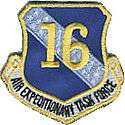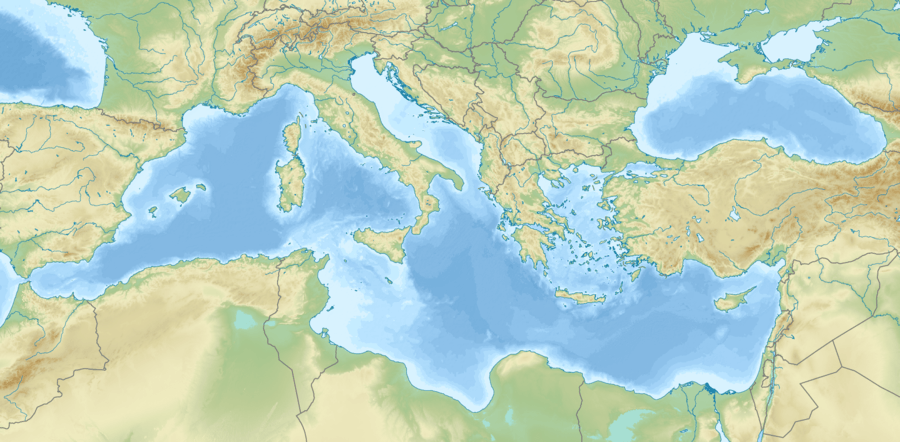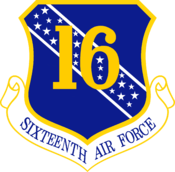16th Air Expeditionary Task Force
| 16th Air Expeditionary Task Force | |
|---|---|
|
A side view of a US Air Force F-16C Fighting Falcon aircraft of the 31st Fighter Wing landing upon returning from an airstrike against the Bosnian Serbs during Operation Deliberate Force | |
| Active |
1954–2006 2006–2008 |
| Country |
|
| Branch |
|
| Part of |
|
| Engagements |
|
| Decorations |
|
| Commanders | |
| Notable commanders | Winfield S. Harpe |
| Insignia | |
| Emblem of the 16th Air Expeditionary Task Force |
 |
The 16th Air Expeditionary Task Force (16 AETF) is a provisional United States Air Force unit assigned to the United States Air Forces in Europe. It was last activated at Izmir Air Base, Turkey on 1 December 2006, and inactivated on 30 April 2008.
The 16 AETF may be activated or inactivated at any time.
Formerly designated as Sixteenth Air Force, the command was the first newly established Numbered Air Force (NAF) by the USAF after World War II, It was activated in 1954 as a Joint Military Group to provide command and control of USAF activities in Spain, being designated a NAF in 1956. In 1957 16th AF was realigned under Strategic Air Command to provide command and control of SAC bases and B-47 Stratojet rotational units assigned and deployed to Spain and Morocco.
In 1966 after SAC withdrew its forces from Europe, 16th AF became part of the United States Air Forces in Europe, providing command and control of USAFE forces initially in Spain and North Africa, and later in Italy and Turkey until 2006. It later became a provisional Air Expeditionary Task Force under USAFE as part of the Global War on Terrorism.
History
Cold War
During the Cold War, the Sixteenth Air Force (16th AF) served both Strategic Air Command and United States Air Forces in Europe.
The 16th AF's ancestor organization was the Joint United States Military Group, Air Administration (Spain), which was established on 20 May 1954. It was attached to the Joint U.S. Military Group, which oversaw implementation of the 1953 Spanish-American Defense Cooperation Agreement.
On 15 July 1956,[1] the Sixteenth Air Force was created when the Air Administration (Spain) was re-designated as Headquarters, 16th AF, and aligned directly under Headquarters, U.S. Air Force. Existing Spanish Air Force bases near Madrid, Sevilla, and Zaragoza were expanded to accommodate the 16th AF. In 1957, the 16th AF was realigned under the Strategic Air Command (SAC). Its main operating bases in Spain were used for SAC B-47 Stratojet rotational alert aircraft until April 1965.
The 16th AF also operated SAC bases in Morocco from 1958 through 1963. In 1966, a year after SAC withdrew its B-47 alert force from Spain, the 16th AF was reassigned to U.S. Air Forces in Europe. The 401st Tactical Fighter Wing, with three squadrons of F-100D Super Sabres, moved from the United States to Torrejon Air Base, Spain. The wing later converted to F-4 Phantom IIs, and in 1983, to F-16 Fighting Falcons.
In 1961, General David Wade was dispatched to Torrejón, where he took command of SAC's 16th Air Expeditionary Task Force. He received his promotion to lieutenant general on 1 August 1963 and left Torrejón to assume command of SAC's Second Air Force with headquarters then at Barksdale Air Force Base in Bossier City, Louisiana.[2]
Structure in 1989
At the end of the Cold War Sixteenth Air Force consisted of the following units:
- Sixteenth Air Force, at Torrejón Air Base, Spain[3][4][5]
- 401st Tactical Fighter Wing, at Torrejón Air Base
- 612th Tactical Fighter Squadron, with 24x F-16C Block 30 Falcon
- 613th Tactical Fighter Squadron, with 24x F-16C Block 30 Falcon
- 614th Tactical Fighter Squadron, with 24x F-16C Block 30 Falcon
- Detachment 2, at Morón Air Base, Spain
- 406th Tactical Fighter Training Wing, at Zaragoza Air Base, Spain, supporting squadrons training at the Bardenas Reales Air-to-Ground Range
- 487th Tactical Missile Wing, at Comiso Air Base, Italy
- 302nd Tactical Missile Squadron, with 112x BGM-109G Ground Launched Cruise Missiles
- 40th Tactical Group, at Aviano Air Base, Italy, supporting squadrons training at the Maniago Air-to-Ground Range
- 7401st Munitions Support Squadron, at Rimini Air Base, Italy
- 7402nd Munitions Support Squadron, at Ghedi Air Base, Italy
- The United States Logistics Group (TUSLOG), at Ankara Air Station, Turkey
- 39th Tactical Group, at Incirlik Air Base, Turkey
- 7217th Air Base Group, at Ankara Air Station
- 7241st Air Base Group, at Izmir Air Station
- 7022d Air Base Squadron, at Pirinçlik Air Station, Turkey
- 7391st Munitions Support Squadron, at Balıkesir Air Base
- 7392nd Munitions Support Squadron, at Eskisehir Air Base
- 7393rd Munitions Support Squadron, at Murted Air Base
- 7394th Munitions Support Squadron, at Erhac Air Base
- 7206th Air Base Group, at Hellenikon Air Base, Greece
- 7061st Munitions Support Squadron, at Araxos Air Base, Greece
- 7275th Air Base Group, at San Vito dei Normanni Air Station, Italy
- 6917th Electronic Security Squadron, operating a AN/FLR-9 Wullenweber radio direction finding antenna array
- 7276th Air Base Group, at Iraklion Air Station, Crete, Greece
- 6931st Electronic Security Squadron (SIGINT unit)
- 7555th Tactical Training Squadron, at Decimomannu Air Base, Italy, supporting squadrons training at the Air Combat Maneuvering and Instrumentation Range (ACMI) to the West of Sardinia
- 7116th Tactical Control Flight, at Torrejón Air Base
- 7120th Air Base Flight, at Morón Air Base
- 401st Tactical Fighter Wing, at Torrejón Air Base

From 1992
The 401st FW moved from Spain to Aviano AB, Italy, in May 1992 and was re-designated as the 31st FW in April 1994. It has two squadrons of F-16C/Ds. Headquarters, 16th AF moved to Aviano AB in August 1992.
During its time at Aviano AB, Sixteenth Air Force was the operational air force for USAF combat operations in the Balkans, supporting Operation Deny Flight, enforcing the U.N. ordered no-fly zone over Bosnia. Sixteenth Air Force aircraft participated in the raid on the Bosnian-Serb held airfield at Udbina in November 1994. In the fall of 1995, 16th AF supported Operation Deliberate Force, the U.N.-sanctioned/NATO executed attacks on Bosnian-Serb forces. In 1995, 16th AF supported Operation Joint Endeavor, the NATO peacekeeping mission to the former Yugoslavia, through operations in Croatia, Hungary and Bosnia-Herzegovina.
The years 1996 through 1998 saw continued high operations in 16th AF. It was the first Air Force organization to fully employ the Expeditionary Wing concept. The 16th Air and Space Expeditionary Task Force, consisting of the 16th and 31st Air Expeditionary Wings, activated in support of Operation Joint Guardian, and its air component, Operation Deliberate Guard, engaging air power for peace enforcement operations in Bosnia-Herzegovina. The 39th Air & Space Expeditionary Wing activated in support of Operation Northern Watch, engaging air power to enforce the no-fly zone over northern Iraq.
Headquarters 16th AF formed the joint force air component command for Operation Silver Wake, the evacuation of Americans and allied noncombatants from Albania. The 31st Fighter Wing was the first F-16 Falcon unit to fly combat missions utilizing night vision goggles, and wing aircraft provided close air support during Pope John Paul II's historic visit to Sarajevo. Today the wing remains a major participant in support of Balkan air operations. The 39th Wing at Incirlik AB, Turkey, deployed a flying ambulance surgical team to Dhahran Air Base, Saudi Arabia in response to the Khobar Towers bombing. The wing assisted in the evacuation of nearly 6,500 pro-U.S. Kurds from northern Iraq.
Beginning in March 1999, the 16th Air and Space Expeditionary Task Force grew to 10 air expeditionary wings and 480 Air Force aircraft in 10 countries supporting Operation Allied Force, NATO's air campaign in the Former Republic of Yugoslavia. Approximately 13,200 airmen, in addition to 32,000 airmen through Europe, deployed in support of the 78-day air campaign that led to Serbian withdrawal of forces from the province of Kosovo.
In 2005, Sixteenth Air Force moved to Ramstein AB, Germany to become USAFE's new Warfighting Headquarters. Its mission was to execute aerospace operations through expeditionary force command and control in support of the U.S. European Command and NATO. Supporting this mission, 16th AF planned and executed combat air operations in southern Europe and portions of the Middle East and northern Africa as an air component or joint task force headquarters. It supported approximately 11,000 Air Force and civilian members at two main operating bases, four support bases and other sites in Spain, France, Germany, Italy, Croatia, Kosovo, Bosnia-Herzegovina, Hungary, Macedonia, Greece, Turkey and Israel; and conducted peacetime engagement throughout the region.
On 1 December 2006, the Sixteenth Air Force was inactivated at Ramstein AB and simultaneously reconstituted as the Sixteenth Air Expeditionary Task Force at Izmir Air Base, Turkey. It was replaced at Ramstein by the Third Air Force. The 16th AETF was inactivated in April 2008.
Lineage

- Established as Joint United States Military Group, Air Administration (Spain)
- Activated on 20 May 1954 as a separate operating agency of the USAF
- Re-designated Sixteenth Air Force on 15 July 1956 and elevated to Major Command status.
- Inactivated 1 December 2006
- Re-designated as 16th Air Expeditionary Task Force and converted to provisional status on 1 December 2006
Assignments
- HQ, United States Air Force, 20 May 1954
- Strategic Air Command, 1 July 1957
- United States Air Forces in Europe, 15 April 1966 – 1 December 2006
- For activation or inactivation any time after 1 December 2006
- Activated on 1 December 2006; Inactivated on 30 April 2008
Components
Air Divisions
- 5th Air Division, 1 July 1957 – 15 January 1958
- 65th Air Division, 8 April 1957 – 1 July 1960
- 4310th Air Division, 15 January 1958 – 15 August 1963
Wings
- 7602d Support Wing, 1 January – 10 May 1957 (Zaragoza AB)
- 3977th Support Wing, 10 May 1957 – 1 April 1958 (Moron AB)
- 31st Fighter Wing (later Air Expeditionary Wing)
- 15 April 1994 – 1 December 2006 (Aviano AB)
- 9 September 1970 – 15 October 1991 (Incirlik AB)
- 17 July 199 – 1 November 2005
- 16th Air Expeditionary Wing, 1 December 2006 – 30 April 2008
- 401st Air Expeditionary Wing (Dates to be determined)
Stations
- Madrid, Spain, 20 May 1954
- Torrejon Air Base, Spain, 1 February 1958
- Aviano Air Base, Italy, 10 August 1992 – 1 December 2006
- Izmir Air Base, Turkey, 1 December 2006 – 30 April 2008
Notes
- ↑ afhra.af.mil Fact Sheet: SIXTEENTH AIR FORCE (USAFE)
- ↑ "Lieutenant General David Wade". United States Air Force Military Information Biographies. Archived from the original on 2013-03-11. Retrieved June 10, 2012.
- ↑ "Sixteenth Air Force (USAFE) Fact Sheet". US Air Force Historical Research Agency. Retrieved 1 November 2016.
- ↑ Butler, William M. (1 May 2004). "Fifty Years On Nato's Southern Flank - A History Of Sixteenth Air Force 1954 – 2004" (PDF). Office of History Headquarters, Sixteenth Air Force United States Air Forces in Europe Aviano Air Base, Italy. p. 43. Retrieved 1 November 2016.
- ↑ Dragoner, O. W. (September 2013). "United States Air Force 1989" (PDF): 184 – 190. Retrieved 1 November 2016.
References
![]() This article incorporates public domain material from the Air Force Historical Research Agency website http://www.afhra.af.mil/.
This article incorporates public domain material from the Air Force Historical Research Agency website http://www.afhra.af.mil/.
- Ravenstein, Charles A. (1984). Air Force Combat Wings Lineage and Honors Histories 1947–1977. Maxwell AFB, Alabama: Office of Air Force History. ISBN 0-912799-12-9.
- Sixteenth Air Force Factsheet

